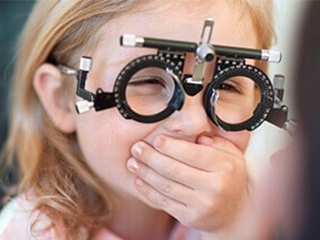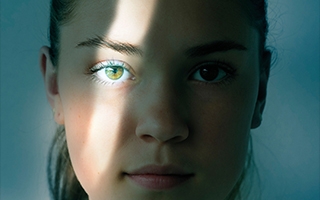35 to 60 percent
If a parent is short-sighted, the child's risk of developing myopia is increased. The risk increases to 35 to 60% if both parents are short-sighted.
MyCon™ lenses - A new solution for short-sighted children

Rodenstock MyCon™ Lenses
Whether it's tablets, computers or homework, today's kids focus more on things right in front of them rather than spending time outdoors. This behavior is leading to more and more children developing myopia - also known as short-sightedness. By 2020, more than one-third of the world's population was short-sighted. This means that there has been a sharp increase within just two decades.
The experts at Rodenstock have developed a solution: Rodenstock MyCon™. These children's lenses are precisely designed to correct myopia, ensure sharp vision and counteract the progression of myopia*.

Children quickly perceive glasses as a constraint. MyCon™ lenses from Rodenstock are available in a variety of indices and can thus be flexibly adapted to a child's needs. Most importantly, they are both thinner and lighter than many other myopia lenses on the market.

Myopia is a consequence of the eye being slightly too long. Conventional single vision lenses can correct myopia, but they are not designed to slow it down. Rather, when corrected with these lenses, light in the periphery is projected behind the retina, causing some children's eyes to grow excessively long and exacerbating short-sightedness.
Rodenstock MyCon™ lenses feature market-proven** HAPD™ Technology. This technology refracts light so that it strikes the periphery in front of the retina rather than behind it. This can slow down eye-length growth. The areas that control myopia progression in a MyCon™ lens are arranged laterally. This ensures sharp vision not only in the center of the lens but also above and below.
To be effective, Rodenstock’s MyCon™ lenses features market-proven** HAPD™ Technology (Horizontal Asymmetrical Peripheral Defocus). Unlike single vision lenses, this approach offers two benefits in one: it ensures sharp, clear, and comfortable vision as well as effective myopia progression control.** To this end, a “focal area” with your child’s prescription is used, along with asymmetrical “progression control areas” in the horizontal lens periphery, combined with a gentle transition.
MyCon™ 2

We go one step further
Children develop quickly and individually, just like their faces and eyes. With MyCon™ 2, Rodenstock takes four individual wearing parameters into account when calculating the lens. This enables even more precise adaptation to the fit of the frame and therefore to your child's unique face to ensure optimum effect and visual comfort with lenses for myopia control.
In general, it is recommended by opticians and ophthalmologists to have the statutory health and medical check-ups carried out.

If you have the feeling that your child may need a pair of spectacles, you should watch out for the following distinctive features:
• Cloudy cornea
• Squint
• Frequent blinking/rubbing eyes
• Particular sensitivity to light
• Noticeable squinting of the eyes
• Uncertainty when gripping and grasping
• Incorrect assessment of distance to obstacles
• Headaches, fatigue, poor concentration

Many visual impairments are hereditary and can be corrected with timely detection. If parents or siblings have eye diseases, the paediatrician should transfer the patient to a specialist ophthalmologist between the 6th and 12th month of life.

Learning to see is like learning to walk, it happens automatically. But vision can only fully develop if there is a sharp image on the retina. If defective vision is corrected early on by spectacles, lifelong vision impairments that are no longer reversible can be avoided or reduced.
*An independent clinical study examining the progression of myopia in European children aged 7 to 14 over a 5-year period has shown that myopia control lenses based on Rodenstock MyCon™ principles can reduce myopia progression by up to 40%.
**Rodenstock. Rodenstock MyCon White Paper Compendium. 2025. (https://www.rodenstock-pro.com/com/mycon-whitepaper)